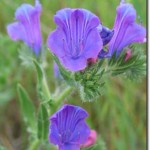
Leslie Weston, Charles Sturt University, Wagga Wagga
Leslie Weston has discovered and patented two weedkillers made by plants. Now she’s investigating Patterson’s curse to see what tricks it uses to invade grasslands and repel herbivores. Her vision is to use plants or plant extracts to control plants, as an alternative to synthetic pesticides and herbicides.
It’s not a new idea – we’ve used pyrethrum (extracted from certain chrysanthemum species) to control insects for years. And lemon grass oil extracts are used for weed management by home owners in the US.
But Leslie’s team at Charles Sturt University in Wagga is taking the idea much further. At the conference she will present the results of her studies into Patterson’s curse, fine fescue and sorghum.
More information here
Abstract
Finding new herbicides in plant roots
Bioactive root exudates: a novel source of allelochemicals and bioherbicides
L. A. Weston
EH Graham Centre for Agricultural Innovation, Charles Sturt University, Wagga Wagga, NSW, Australia
Plant root exudates are known to play an important role in community structure and are involved in complex rhizospheric interactions. Our past work with Sorghum spp. has elucidated the role of the allelochemical sorgoleone, a potent inhibitor of plant growth that is released in sorghum root exudates.
Graminaecous species including fine fescue (Festuca rubra) also produce large amounts of novel secondary products and can selectively inhibit weeds in both field and laboratory conditions. These constituents are known to play important roles in plant defense against herbivores, insects, pathogens and microbes as well as competing plants.
In Australia, Paterson’s curse (Echium plantagineum) also produces unique root exudates from two types of root hairs, which are involved in active exudation processes in the plant. We have discovered that the outer layers of both its younger lateral roots and older taproots produce unusual, red- colored chemical constituents which are localized in the peridermal layers of its roots. Their identification and mode of action is currently under evaluation, as is their role in plant defense and invasion success.